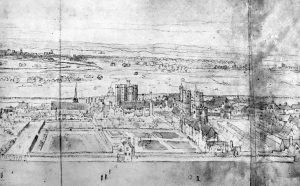

Images: Greenwich palace and gardens, detail of view by Anton van den Wyngaerde, 1560s; a sketch of Greenwich Palace in England, published in The Gentleman’s Magazine in 1840. earlier published by W Bristow in 1797, http://Public Domain, https://commons.wikimedia.org/w/index.php?curid=549097.)
Acquired: 1509 (by inheritance)
Henry VIII was born at Greenwich palace, one of the great palaces of sufficient size to accommodate the entire royal court. The palace contained at least two, and possibly three, courtyards, and a large, freestanding hall. The royal lodgings block ran alongside the river, and a friary church had been built beside the palace in the reign of Henry VII (later suppressed in 1534), although the palace had its own chapel. Henry VIII built extensively at Greenwich, including a number of recreational facilities, such as a jousting tiltyard with towers, a tennis court, dog kennels, hawk mews, a bowling alley, and a cockpit. The palace had extensive gardens and a banqueting house within the grounds. Greenwich was also home to the royal armory.
Anthonis van Wyngaerde’s drawing of the palace in 1558 reveals a river front punctuated by bay windows, a crenellated roofline, and onion-domed cupolas. Building account details for Greenwich during Henry’s reign indicate considerable embellishment and ornamentation to residential structures, including altering the queen’s devices (coats of arms), in the window glass and in other decorations, when the king acquired a new wife.
Christmas celebrations were frequently celebrated at Greenwich, and ambassadors entertained there. Elizabeth used it extensively as well. By the seventeenth century, however, the Tudor structures were swept away for new construction on site, although only Inigo Jones’ Queen’s House for Henrietta Maria remains of this later campaign.
*Click here to see the women vendors that worked at this site.